
The Four Freedoms were goals articulated by U.S. President Franklin D. Roosevelt on Monday, January 6, 1941. In an address known as the Four Freedoms speech, he proposed four fundamental freedoms that people "everywhere in the world" ought to enjoy:
- Freedom of speech
- Freedom of worship
- Freedom from want
- Freedom from fear

Norman Percevel Rockwell was an American painter and illustrator. His works have a broad popular appeal in the United States for their reflection of the country's culture. Rockwell is most famous for the cover illustrations of everyday life he created for The Saturday Evening Post magazine over nearly five decades. Among the best-known of Rockwell's works are the Willie Gillis series, Rosie the Riveter, The Problem We All Live With, Saying Grace, and the Four Freedoms series. He is also noted for his 64-year relationship with the Boy Scouts of America (BSA), during which he produced covers for their publication Boys' Life, calendars, and other illustrations. These works include popular images that reflect the Scout Oath and Scout Law such as The Scoutmaster, A Scout Is Reverent and A Guiding Hand, among many others.

Rosie the Riveter is an allegorical cultural icon in the United States who represents the women who worked in factories and shipyards during World War II, many of whom produced munitions and war supplies. These women sometimes took entirely new jobs replacing the male workers who joined the military. Rosie the Riveter is used as a symbol of American feminism and women's economic advantage.
Joseph Csatari is a realist artist who worked with Norman Rockwell. As a boy, Csatari had painstakingly recreated Saturday Evening Post covers that Rockwell had painted. In 1977, shortly before Rockwell died, Csatari was commissioned as the Boy Scouts of America (BSA)'s official artist.
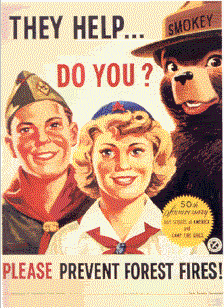
Since Scouting began in 1907, it has entered into many elements of popular culture, including movies, TV and books.
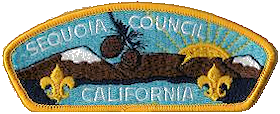
The Sequoia Council serves Fresno, Madera, Kings and Tulare Counties in California. Founded in 1919 as the Fresno Council, it changed its name to Sequoia Council in 1925. In 1992, the Mount Whitney Area Council (#054) merged into Sequoia. The council was the first in California to sponsor an all girl cub scout pack.

Willie Gillis, Jr. is a fictional character created by Norman Rockwell for a series of World War II paintings that appeared on the covers of 11 issues of The Saturday Evening Post between 1941 and 1946. Gillis was an everyman with the rank of private whose career was tracked on the cover of the Post from induction through discharge without being depicted in battle. He and his girlfriend were modeled by two of Rockwell's acquaintances.
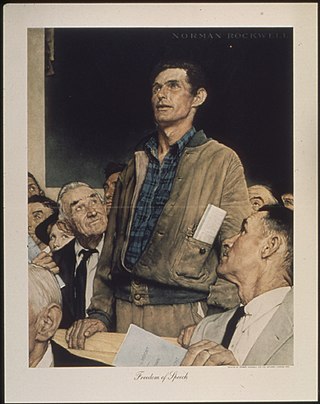
The Four Freedoms is a series of four oil paintings made in 1943 by the American artist Norman Rockwell. The paintings—Freedom of Speech, Freedom of Worship, Freedom from Want, and Freedom from Fear—are each approximately 45.75 by 35.5 inches, and are now in the Norman Rockwell Museum in Stockbridge, Massachusetts. The four freedoms refer to President Franklin D. Roosevelt's January 1941 Four Freedoms State of the Union address, in which he identified essential human rights that should be universally protected. The theme was incorporated into the Atlantic Charter, and became part of the Charter of the United Nations. The paintings were reproduced in The Saturday Evening Post over four consecutive weeks in 1943, alongside essays by prominent thinkers of the day. They became the highlight of a touring exhibition sponsored by The Post and the U.S. Department of the Treasury. The exhibition and accompanying sales drives of war bonds raised over $132 million.

Freedom of Speech is the first of the Four Freedoms paintings by Norman Rockwell, inspired by United States President Franklin D. Roosevelt's 1941 State of the Union address, known as Four Freedoms.
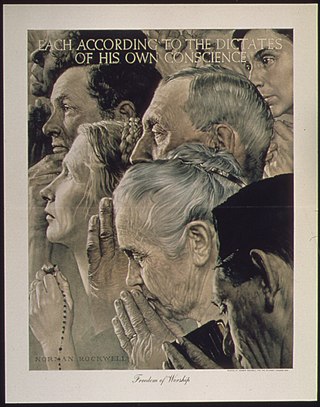
Freedom of Worship or Freedom to Worship is the second of the Four Freedoms oil paintings produced by the American artist Norman Rockwell. The series was based on the goals known as the Four Freedoms enunciated by Franklin D. Roosevelt, president of the United States from 1933 to 1945, in his State of the Union Address delivered on January 6, 1941. Rockwell considered this painting and Freedom of Speech the most successful of the series. Freedom of Worship was published in the February 27, 1943, issue of The Saturday Evening Post alongside an essay by philosopher Will Durant.
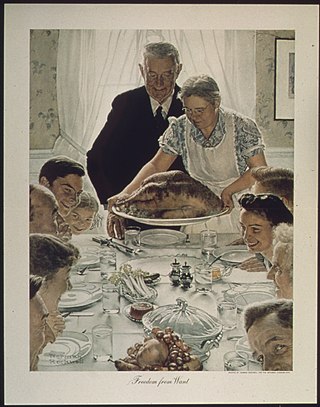
Freedom from Want, also known as The Thanksgiving Picture or I'll Be Home for Christmas, is the third of the Four Freedoms series of four oil paintings by American artist Norman Rockwell. The works were inspired by United States President Franklin D. Roosevelt's 1941 State of the Union Address, known as Four Freedoms.
Bob Hamilton may refer to:

The Problem We All Live With is a 1964 painting by Norman Rockwell that is considered an iconic image of the Civil Rights Movement in the United States. It depicts Ruby Bridges, a six-year-old African-American girl, on her way to William Frantz Elementary School, an all-white public school, on November 14, 1960, during the New Orleans school desegregation crisis. Because of threats of violence against her, she is escorted by four deputy U.S. marshals; the painting is framed so that the marshals' heads are cropped at the shoulders. On the wall behind her are written the racial slur "nigger" and the letters "KKK"; a smashed and splattered tomato thrown against the wall is also visible. The white protesters are not visible, as the viewer is looking at the scene from their point of view. The painting is oil on canvas and measures 36 inches (91 cm) high by 58 inches (150 cm) wide.

Saying Grace is a 1951 painting by American illustrator Norman Rockwell, painted for the cover of The Saturday Evening Post's November 24, 1951, Thanksgiving issue.

The Scoutmaster is a 1956 painting by American illustrator Norman Rockwell. It was originally created by Rockwell for the 1956 Brown & Bigelow Boy Scout Calendar. Since then, it has become one of the most collected images that Rockwell created for the Boy Scouts of America.

Growth of a Leader is a 1964 painting by Norman Rockwell. It appeared as the 1966 Brown & Bigelow Boy Scout Calendar. Long-time Rockwell model James Edgerton and his son are depicted as a Scout moving through the stages of a man's Scouting career.

The Rookie or The Rookie is a 1957 painting by American artist Norman Rockwell, painted for the March 2, 1957, cover of The Saturday Evening Post magazine.
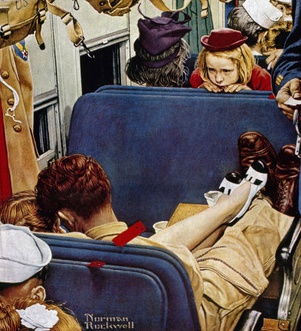
Little Girl Observing Lovers on a Train, also known as Travel Experience or Voyeur, is a painting by American illustrator Norman Rockwell. It was originally created for the cover of The Saturday Evening Post on 12 August 1944.
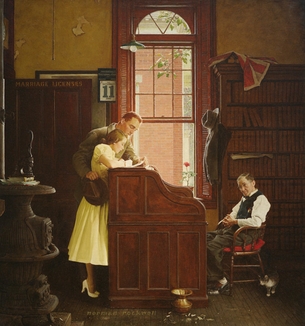
Marriage License is an oil painting by American illustrator Norman Rockwell created for the cover of the June 11, 1955, edition of The Saturday Evening Post. It depicts a young man and woman filling out a marriage license application at a government building in front of a bored-looking clerk. The man is dressed in a tan suit and has his arm around his partner, who is wearing a yellow dress. Although the room and its furnishings are dark, the couple are illuminated by the window beside them. The contrast between the couple and the clerk highlight two reoccurring themes in Rockwell's works: young love and ordinary life.
















